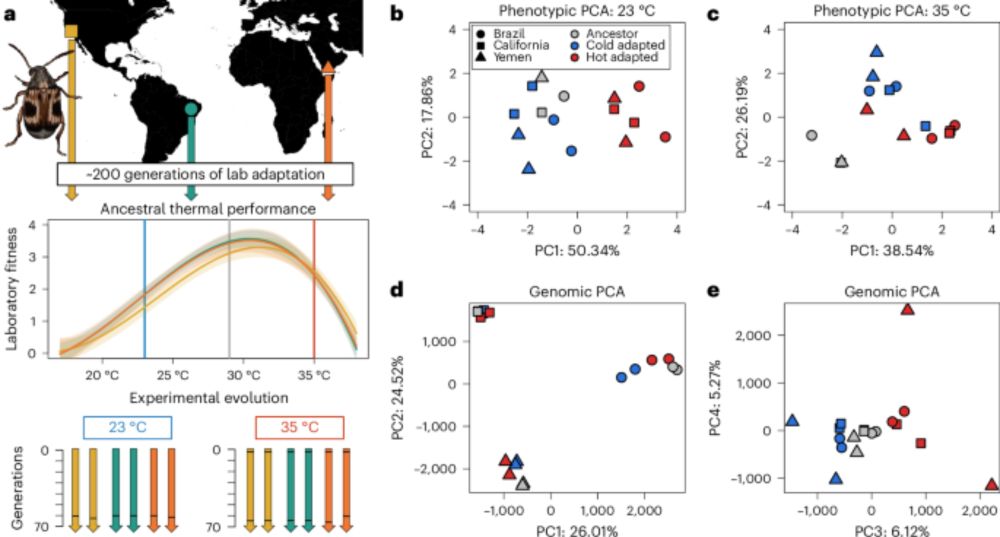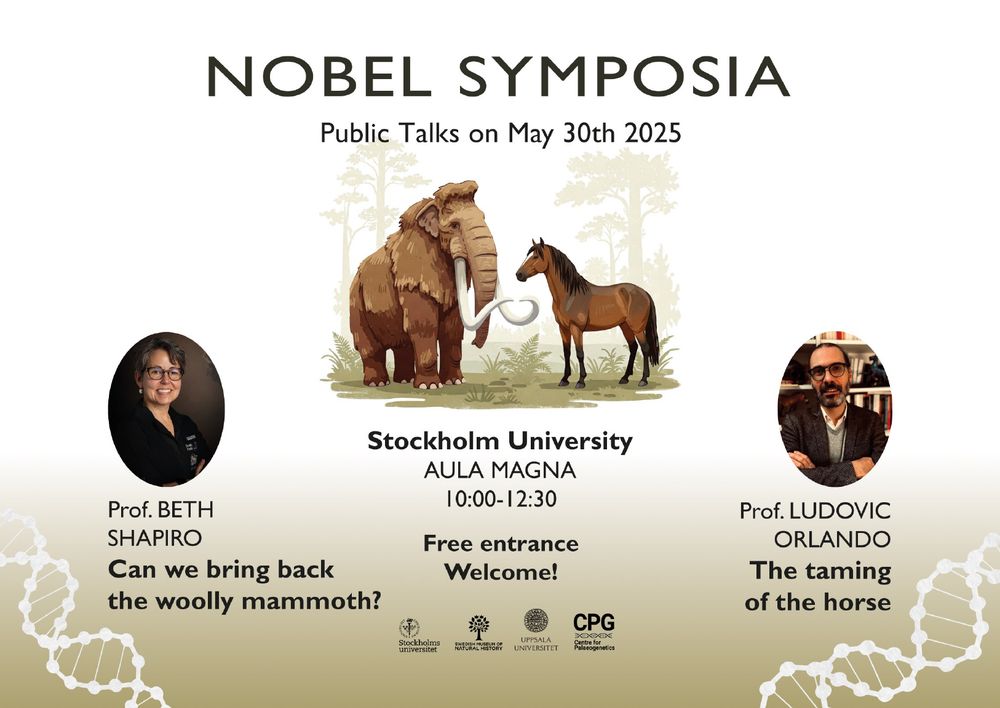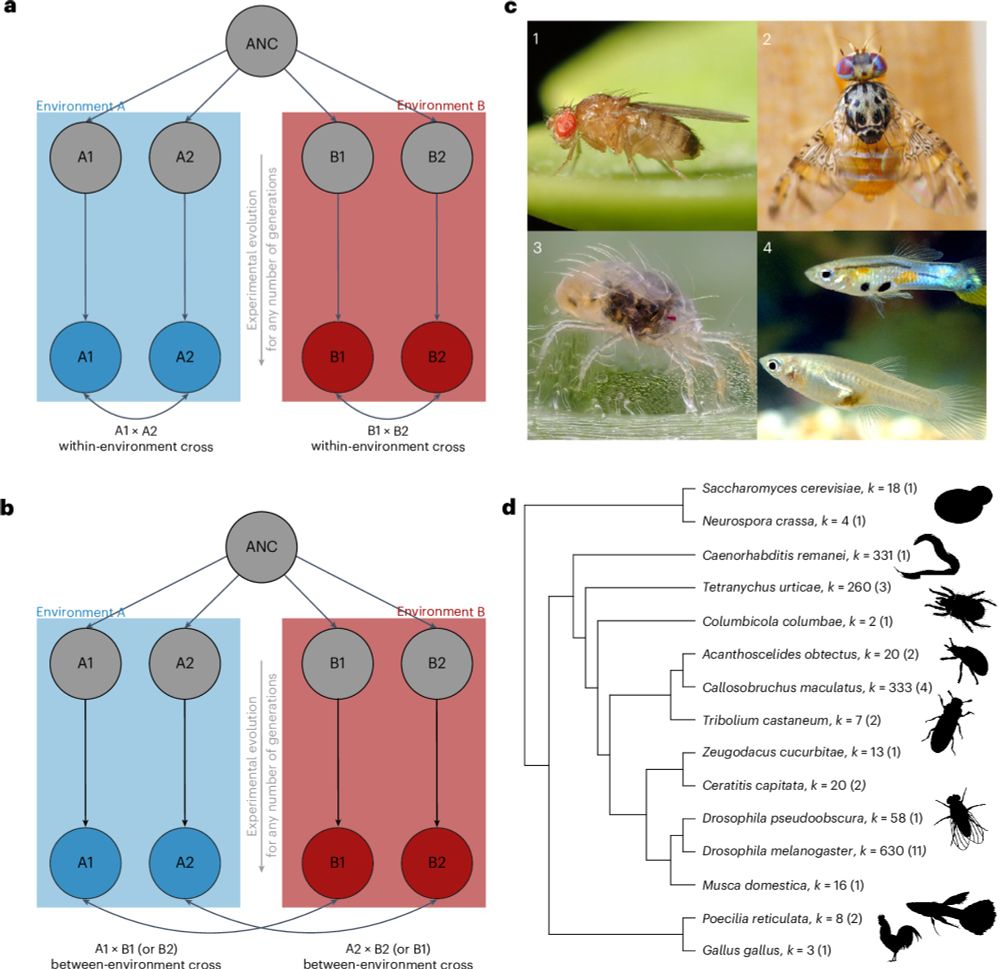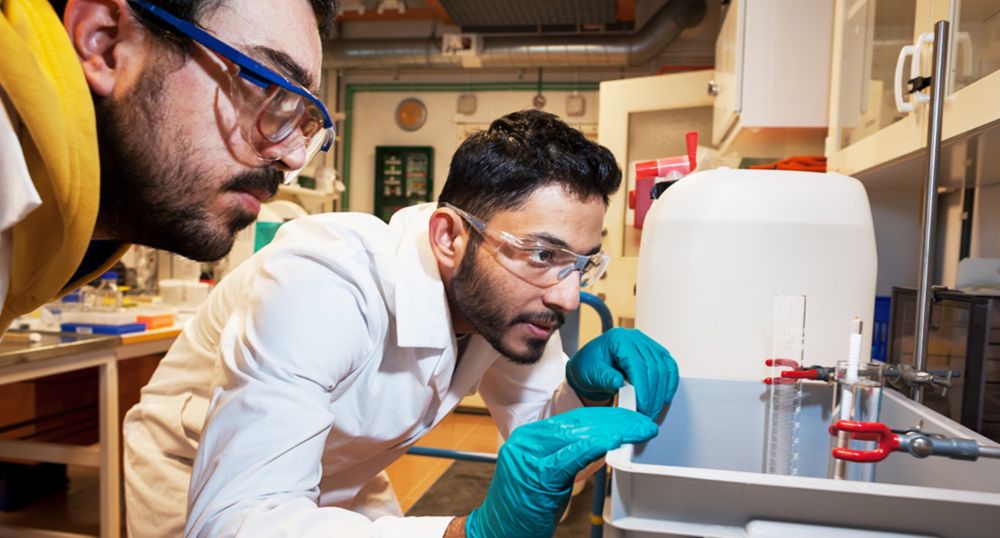Matt Webster
@mwbstr.bsky.social
Evolution and population genetics
https://www.websterlab.net/
https://www.websterlab.net/
Why do queens bees live so much longer than workers? Apply for a postdoc position in my lab to figure it out! Please get in touch if you want to know more.
link to job:
www.uu.se/en/about-uu/...
lab website:
www.websterlab.net
link to job:
www.uu.se/en/about-uu/...
lab website:
www.websterlab.net

November 11, 2025 at 11:34 AM
Why do queens bees live so much longer than workers? Apply for a postdoc position in my lab to figure it out! Please get in touch if you want to know more.
link to job:
www.uu.se/en/about-uu/...
lab website:
www.websterlab.net
link to job:
www.uu.se/en/about-uu/...
lab website:
www.websterlab.net
Reposted by Matt Webster
I have no idea who to credit for this, apologies. But fuck, that's so accurate based on recent workplace conversations I've overheard.

November 5, 2025 at 8:12 PM
I have no idea who to credit for this, apologies. But fuck, that's so accurate based on recent workplace conversations I've overheard.
Reposted by Matt Webster
The exciting next instalment of Mutations in Time and Space... Open for registration now
Explore the origins, patterns and consequences of mutations across biological systems! #MITS26
🗓️ Conference dates: 13-15 April 2026
Participate in expert-led knowledge exchange on how genome evolution shapes human health and ageing 🧬
Check out our exciting speakers ➡️ bit.ly/4hmbnyr
#Genomics
🗓️ Conference dates: 13-15 April 2026
Participate in expert-led knowledge exchange on how genome evolution shapes human health and ageing 🧬
Check out our exciting speakers ➡️ bit.ly/4hmbnyr
#Genomics

November 4, 2025 at 10:28 AM
The exciting next instalment of Mutations in Time and Space... Open for registration now
Latest research from the lab where we mapped the sex-determining gene in the red mason bee. Surprisingly it turned out to be the same gene used by ants, suggesting an ancient origin >150 million years ago. Thanks to the many people involved!
#Haplodiploid inheritance is found in all species of #Hymenoptera. @mwbstr.bsky.social &co map the #sex determining #gene of the red mason #bee to the ANTSR gene region, suggesting a shared, ancient origin of #SexDetermination in bees & ants >150 Mya ago @plosbiology.org 🧪 plos.io/47COEtH

November 4, 2025 at 1:19 PM
Latest research from the lab where we mapped the sex-determining gene in the red mason bee. Surprisingly it turned out to be the same gene used by ants, suggesting an ancient origin >150 million years ago. Thanks to the many people involved!
I'm happy to share our new study where we mapped the sex-determining locus in the red mason bee. It maps to the ANTSR lncRNA discovered in ants, suggesting that this gene determines sex widely in Hymenoptera.
www.biorxiv.org/content/10.1...
www.biorxiv.org/content/10.1...
Genetic mapping in the red mason bee Osmia bicornis implicates ANTSR as an ancient sex-determining locus in bees and ants
Haplodiploid inheritance, in which females are diploid and males are haploid, is found in all species of Hymenoptera. Sex in haplodiploids is commonly determined by the alleles present at a complementary sex determination (CSD) locus, with heterozygosity triggering the female developmental pathway. The identity of this locus differs among taxa and is only known in a few species. Here, we map a single CSD locus to a 2 kbp region in the genome of the red mason bee Osmia bicornis . It overlaps the long noncoding RNA ANTSR , which has been identified as the sex-determining gene in the invasive ant Linepithema humile . This locus is homozygous in diploid males and exhibits extremely high levels of haplotype diversity, consistent with the action of frequency-dependent selection. The elevated levels of heterozygosity in the CSD locus enable us to fine-map potentially functional genetic variation within it. We also identify elevated levels of genetic diversity in the ortholog of the CSD locus in other bee genera, suggesting that it may govern sex determination widely in bees. Our data are consistent with the hypothesis that ANTSR evolved a role in sex determination at least 150 million years ago and is the ancestral sex-determination locus of bees and ants. ### Competing Interest Statement The authors have declared no competing interest. Erik Philip-Sörensens Stiftelse Swedish Research Council, 2022-06725
www.biorxiv.org
July 7, 2025 at 7:17 AM
I'm happy to share our new study where we mapped the sex-determining locus in the red mason bee. It maps to the ANTSR lncRNA discovered in ants, suggesting that this gene determines sex widely in Hymenoptera.
www.biorxiv.org/content/10.1...
www.biorxiv.org/content/10.1...
Fascinating work
Finally out: Predicting adaptation to climate warming www.nature.com/articles/s41...
We find that there are many genomic routes to heat-adaptation, but this can also make genomic data of limited value for prediction. A tour de force by @denovorego.bsky.social , with @stelkens.bsky.social.
We find that there are many genomic routes to heat-adaptation, but this can also make genomic data of limited value for prediction. A tour de force by @denovorego.bsky.social , with @stelkens.bsky.social.

Repeatability of evolution and genomic predictions of temperature adaptation in seed beetles - Nature Ecology & Evolution
The authors compare genomic and phenotypic changes between genetic backgrounds of seed beetles evolved at hot or cold temperatures. Despite phenotypic changes being more rapid and predictable at hot t...
www.nature.com
May 20, 2025 at 11:48 AM
Fascinating work
Reposted by Matt Webster
NOBEL SYMPOSIA
We are delighted to announce two exciting public talks on Ancient DNA at Aula Magna (Stockholm University) on May 30th, 10:00-12:30h.
🦣⬅️ ”Can we bring back the woolly mammoth?” by Beth Shapiro.
🐎✋”The taming of the horse” by Ludovic Orlando.
Free entrance. All welcome!
We are delighted to announce two exciting public talks on Ancient DNA at Aula Magna (Stockholm University) on May 30th, 10:00-12:30h.
🦣⬅️ ”Can we bring back the woolly mammoth?” by Beth Shapiro.
🐎✋”The taming of the horse” by Ludovic Orlando.
Free entrance. All welcome!

April 30, 2025 at 3:08 PM
NOBEL SYMPOSIA
We are delighted to announce two exciting public talks on Ancient DNA at Aula Magna (Stockholm University) on May 30th, 10:00-12:30h.
🦣⬅️ ”Can we bring back the woolly mammoth?” by Beth Shapiro.
🐎✋”The taming of the horse” by Ludovic Orlando.
Free entrance. All welcome!
We are delighted to announce two exciting public talks on Ancient DNA at Aula Magna (Stockholm University) on May 30th, 10:00-12:30h.
🦣⬅️ ”Can we bring back the woolly mammoth?” by Beth Shapiro.
🐎✋”The taming of the horse” by Ludovic Orlando.
Free entrance. All welcome!
Reposted by Matt Webster
Divergent selection and plasticity increases reproductive isolation early during incipient speciation. Find our new meta-analysis on experimental speciation studies here: rdcu.be/ek019 🧪 @EvolOdonata.ecoevo.social.ap.brid.gy @pipdowning.bsky.social

Meta-analysis reveals that phenotypic plasticity and divergent selection promote reproductive isolation during incipient speciation
Nature Ecology & Evolution - The authors examine factors affecting reproductive isolation in the early stages of speciation by collating data from 34 experimental speciation studies in 15...
rdcu.be
May 7, 2025 at 3:32 PM
Divergent selection and plasticity increases reproductive isolation early during incipient speciation. Find our new meta-analysis on experimental speciation studies here: rdcu.be/ek019 🧪 @EvolOdonata.ecoevo.social.ap.brid.gy @pipdowning.bsky.social
I enjoyed the first installment of MAYosis yesterday. Highly recommended seminar series for those interested in recombination and evolution!
meiosis.cornell.edu/mayosis2025/...
meiosis.cornell.edu/mayosis2025/...
MAYosis 2025
meiosis.cornell.edu
May 8, 2025 at 6:58 AM
I enjoyed the first installment of MAYosis yesterday. Highly recommended seminar series for those interested in recombination and evolution!
meiosis.cornell.edu/mayosis2025/...
meiosis.cornell.edu/mayosis2025/...
Reposted by Matt Webster
PhD position in evolutionary genetics in Linköping, with Urban Friberg. Mutation rates, flies, lots of sequencing, quantitative genetics!
Please pass on to those who might be interested. :)
liu.se/en/work-at-l...
Please pass on to those who might be interested. :)
liu.se/en/work-at-l...

PhD student in Biological Sciences
liu.se
March 31, 2025 at 7:26 AM
PhD position in evolutionary genetics in Linköping, with Urban Friberg. Mutation rates, flies, lots of sequencing, quantitative genetics!
Please pass on to those who might be interested. :)
liu.se/en/work-at-l...
Please pass on to those who might be interested. :)
liu.se/en/work-at-l...
Reposted by Matt Webster
Two more weeks to apply for a PhD position in our yeast genomics and evolution lab at Stockholm University! Please share widely. 🧪🧬🌳🍄
We have a 4-year fully funded PhD position available! Research topics include but are not limited to 1) Parallel evolution of climate adaptation in Europe and South America 2) The genetic architecture of temperature adaptation 3) The evolution of pathogenicity su.varbi.com/en/what:job/...

PhD student in Evolutionary Genomics with Yeast
The Department of Zoology of Stockholm University includes ca. 80 employees, including researchers, PhD students, and administrative staff. Research and education at the department occurs in an intern
su.varbi.com
April 8, 2025 at 9:52 AM
Two more weeks to apply for a PhD position in our yeast genomics and evolution lab at Stockholm University! Please share widely. 🧪🧬🌳🍄
Reposted by Matt Webster
Come get your PhD with me, and at @stockholm-uni.bsky.social and @scilifelab.se ! :)
We are recruiting PhD student to work on genomics of seasonal camouflage in ptarmigan! There is still a week to apply!
#Genomics #PopGen #Evolution #Camouflage #Birds #PhDPosition #PhDStudent
#Genomics #PopGen #Evolution #Camouflage #Birds #PhDPosition #PhDStudent
PhD position on Evolution of Seasonal Camouflage in my group. Fully funded 4 year position in Stockholm University and SciLifeLab! :-)
su.varbi.com/en/what:job/...
su.varbi.com/en/what:job/...
April 14, 2025 at 5:32 PM
Come get your PhD with me, and at @stockholm-uni.bsky.social and @scilifelab.se ! :)
Reposted by Matt Webster
@hybridzones.bsky.social, @nemovrobles.bsky.social and @majorodriguezb.bsky.social scoured the literature to find the examples in Table 1. Is your favorite incompatibility gene missing? Please let us know so we can update the table and make a complete resource! Other feedback on the paper welcome
April 10, 2025 at 5:52 PM
@hybridzones.bsky.social, @nemovrobles.bsky.social and @majorodriguezb.bsky.social scoured the literature to find the examples in Table 1. Is your favorite incompatibility gene missing? Please let us know so we can update the table and make a complete resource! Other feedback on the paper welcome
Reposted by Matt Webster
We have an open 4-year PhD position in the Slotte lab at Stockholm University, to investigate genomic signatures of selection associated with pollination mode shifts.
Full ad: su.varbi.com/en/what:job/...
Apply by April 22, 2025 via the University application portal (link). Please repost! 🧪
Full ad: su.varbi.com/en/what:job/...
Apply by April 22, 2025 via the University application portal (link). Please repost! 🧪

PhD student in Ecology and Evolution
The Department of Ecology, Environment and Plant Sciences (DEEP) is located in the Arrhenius Laboratories, situated at the University Campus at Frescati. Presently around 100 people, including 35 PhD
su.varbi.com
April 1, 2025 at 2:41 PM
We have an open 4-year PhD position in the Slotte lab at Stockholm University, to investigate genomic signatures of selection associated with pollination mode shifts.
Full ad: su.varbi.com/en/what:job/...
Apply by April 22, 2025 via the University application portal (link). Please repost! 🧪
Full ad: su.varbi.com/en/what:job/...
Apply by April 22, 2025 via the University application portal (link). Please repost! 🧪
Great opportunity to become a PhD student in Urban Friberg's lab in Linköping Uni studying somatic mutations and ageing: liu.se/en/work-at-l...
March 28, 2025 at 9:48 AM
Great opportunity to become a PhD student in Urban Friberg's lab in Linköping Uni studying somatic mutations and ageing: liu.se/en/work-at-l...
Our paper on recombination rate in termites is out! Our findings suggest that crossover rates are not universally high in social insects. We also find evidence for active PRDM9 and hotspots in an insect.
genome.cshlp.org/content/earl...
genome.cshlp.org/content/earl...
Unexpectedly low recombination rates and presence of hotspots in termite genomes
An international, peer-reviewed genome sciences journal featuring outstanding original research that offers novel insights into the biology of all organisms
genome.cshlp.org
March 22, 2025 at 9:55 AM
Our paper on recombination rate in termites is out! Our findings suggest that crossover rates are not universally high in social insects. We also find evidence for active PRDM9 and hotspots in an insect.
genome.cshlp.org/content/earl...
genome.cshlp.org/content/earl...

